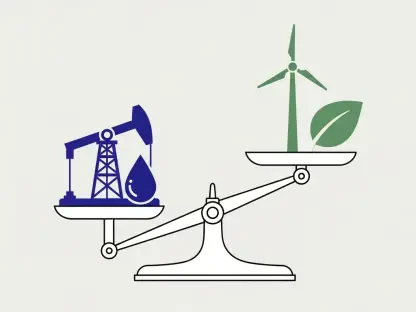The global energy landscape is undergoing a remarkable transformation, with a significant focus on solar energy adoption. Among the nations propelling this change, Saudi Arabia and Pakistan have emerged as unexpected leaders, sparking a solar revolution that is reshaping their energy futures. As energy demands soar and the urgency to combat climate change intensifies, these two countries are taking significant steps to integrate renewable resources into their energy strategies, ultimately setting a precedent for other nations to follow.
A Surge in Solar Energy Adoption
China, the dominant player in the solar panel market, continues to play a crucial role in the global energy transition. In 2024, Chinese solar panel exports grew, albeit at a slower pace compared to previous years. This growth highlights China’s significant influence in providing essential technology for countries eager to diversify their energy portfolios and reduce carbon footprints. The surge in solar installations worldwide underscores the increasing reliance on solar panels as a viable and sustainable energy solution.
The export trends indicate a notable shift towards the global south, with countries in these regions increasingly adopting solar energy. This trend reflects the rising energy demands, favorable economic conditions, and a collective pursuit of sustainable energy solutions among developing nations. China’s contribution to meeting these needs through its robust manufacturing and export capabilities remains a pivotal factor in the broader global market dynamics.
The Role of the Global South
Saudi Arabia has set one of the most ambitious renewable energy targets globally. With vast desert areas perfect for solar farms and the commitment of the government, the country is moving rapidly towards integrating solar energy into its power grid. The goal of achieving 50% renewables in the energy mix by 2030 is not only altering the local energy landscape but also setting a global benchmark. International energy firms play a critical role in this transition by facilitating large-scale projects that are economically viable, driving down electricity prices, and ensuring project success.
Support from international firms is vital for Saudi Arabia’s renewable energy ambitions. These partnerships leverage advanced technologies, financial investments, and expertise to develop large-scale solar farms. The presence of these global players in the region underscores the potential for achieving some of the world’s lowest reported electricity prices. The collaborative effort is transforming Saudi Arabia into a model for renewable energy adoption on an international scale, cementing its role as a leader in the solar energy revolution.
Pakistan’s Solar Boom
Pakistan’s rapid increase in solar installations is primarily driven by rising electricity costs and frequent power shortages. These economic pressures and infrastructural challenges have led to a surge in small-scale, consumer-funded projects. These installations are becoming the norm, addressing immediate local energy needs effectively. The decentralized approach, while addressing the energy shortfall, also helps households and small businesses reduce their dependence on the national grid, fostering a sense of energy independence.
However, despite significant growth in small-scale projects, Pakistan has seen minimal progress in large-scale utility projects and almost no advancement in battery storage solutions. This reliance on smaller initiatives reflects the country’s unique approach to meeting its energy demands. The focus on decentralized solar projects highlights the immediate benefits of solar adoption, although the lack of large-scale infrastructure may pose challenges for future scalability. Pakistan’s journey towards solar energy demonstrates how localized actions can collectively make a substantial impact on national energy security.
Expanding New Markets
Emerging markets such as Nigeria, Algeria, and Iraq are showing significant growth in solar panel imports. These regions, often grappling with local energy challenges, are increasingly turning to solar power as a sustainable solution. The shift towards solar energy in these countries is driven by the need to address energy shortages, diversify energy sources, and enhance sustainability. The rapid adoption of solar panels signifies a broader acceptance of renewable energy as a viable alternative to traditional power sources.
Smaller countries in Africa and Latin America are also witnessing a notable increase in solar panel imports. This trend is likely driven by attractive discounts and year-end sales targets from Chinese manufacturers. As these nations seek to meet their energy demands sustainably, the affordability and availability of solar panels play a crucial role in their energy strategies. The rise in solar adoption among smaller countries highlights the potential for solar energy to provide accessible and reliable power solutions, fostering long-term economic growth and environmental benefits.
China’s Domestic Solar Growth
The global energy landscape is experiencing a significant shift, with a growing emphasis on the adoption of solar power. Saudi Arabia and Pakistan have emerged as surprising frontrunners in this solar revolution, significantly altering their energy futures. With rising energy demands and the urgent need to address climate change, these nations are making notable strides in incorporating renewable resources into their energy strategies. This proactive approach not only meets their immediate energy needs but also creates a model for other countries to emulate.
Saudi Arabia, traditionally known for its vast oil reserves, is investing heavily in solar projects to diversify its energy portfolio. The kingdom’s ambitious Vision 2030 plan aims to reduce its dependence on oil and achieve more sustainable energy sources. Mega solar projects like the Sakaka solar plant symbolize this commitment to a greener future.
Similarly, Pakistan, grappling with chronic energy shortages, has turned to solar energy as a solution. The country is implementing extensive solar energy projects to provide reliable and clean electricity to its population. Efforts like the Quaid-e-Azam Solar Park are playing a pivotal role in transforming Pakistan’s energy landscape.
In summary, Saudi Arabia and Pakistan are leading a solar energy movement, setting standards for renewable energy integration that other nations may soon follow.









